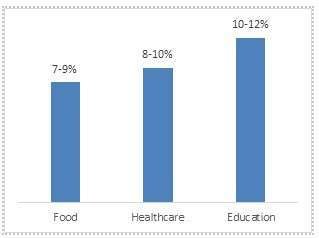How education inflation can hurt a child’s future?

Inflation has been a buzzword globally since Covid19 pandemic was over. Almost every country has been witnessing high inflation, and some are seeing skyrocketing inflation in a few decades.
The rise in the price of cars, electronics, food, and fuel only reminds us how household goods and consumption items are becoming costlier.
While discussing the fuel price has been all the rage, there are some items where inflation has been hovering around for quite some time and that too consistently.
This is nothing but Education. Unfortunately, this area needs to be spoken about more, as people are aloof about how it is not only making a hole in your pocket but also denting your aspiration.

Education inflation is the silent killer and is for real. But why is it so critical?
Because it can demolish the dreams of a brighter future when taken lightly. Here’s an example that proves this powerful statement – Despite the pandemic, IITs increased their fees in 2021-22 from INR 90K to INR 200K. This is over 100%.
So, a financially unprepared parent will face the heat of the situation with their child for admission!
Why is education inflation scary?
Below is the list of different segments and inflation over the last ten years.

The data highlights the reality that the rise in education costs has surpassed all other necessities and consumables in the last decade.
This rise is partial because the government is looking to reduce funding grants. Additionally, there has been growth in living standards and services offered by the Educational Institutes and thus the premium.
In addition to headline educational expenses, many hidden costs hurt a parent. For instance, exam registration fees saw an approximate 6.7% hike last year.
Additionally, transportation and student accommodation costs contribute significantly to the overall increase in education costs. And finally, food costs are another major contributor that needs to be highlighted while planning for higher Education.
Increasing tuition fees in India
College tuition fees in India have seen an enormous rise over the years. Here is some data on total course fees for specific courses that help paint a clearer picture of how fast the tuition fees have risen over the years.

The figures are staggering, and one of the main reasons students drop out of college midway. According to recent data, approximately 39% of students aged 20-24 drop out of college to help their family increase their household income.
Therefore, it is becoming increasingly apparent that there is a need for proper education planning in India, as many parents need to be aware of the rising tuition fee and how to tackle it.
Education costs abroad on the rise
If you want to send your child abroad, the cost will be higher, and you must be prepared to shell out much more to pay.
But why?
Because, in addition to inflation or price hike, currency depreciation also hurts you.
So, even if the college abroad doesn’t increase the fees, you will pay higher Indian Rupee terms because of the depreciating Rupee. And, if the colleges increase fees (which they have done every year), the cost increases further in Indian Rupees.
Cost of Education in Indian Rupee when fees don’t increase
| Jan-22 | Jan-23 | Change (%) | ||
| Fees | USD | 79,540 | 79,540 | 0% |
| USD | INR | Rs | 74.51 | 82.74 | 11% |
| Fees | Rs Lakhs | 59.3 | 65.8 | 11% |
Source: https://admission.princeton.edu/
Fees in the United States increased to nearly 5x from what it was in 1985. The scenario is similar for destinations like the UK, Canada, and Australia.
Despite the pandemic, some universities abroad announced increasing the tuition fee for this academic year (2022-2023). The University of Pennsylvania announced a 2.9% increase in tuition fees, while Arizona State University announced that tuition fees would increase by 5% for international students.
The international students at all three campuses of the University of Illinois are likely to see a 1.5 to 2.5% hike in their tuition fees.
How are you planning for your life’s most considerable expense before retirement?
Unfortunately, the depth of the issue only hits you once you are close to paying for your child’s college, which is one or two years before.
And suddenly, you are left with only two choices- compromising on the quality of Education or opting for loans with a high-interest rate which eventually increases your overall cost of Education (after including the interest component on loan). Both decisions will have a significant impact on your child’s future.
But you can avoid it. How?
You can avoid financial stress by saving early for your child’s college. The sooner you begin investing in your child’s education expenses, the more time you give your savings to grow. Here is an example of how you could create an education fund for your child by investing early:
| Unit | 5 yrs. | 10 yrs. | 15 yrs. | |
| SIP | Rs/month | 10,000 | 10,000 | 10,000 |
| Annual Returns | % Per Annum | 15 | 15 | 15 |
| Total Outflow | Rs | 6,00,000 | 12,00,000 | 18,00,000 |
| Accumulated Amount | Rs | 8,96,817 | 27,86,573 | 67,68,631 |
Source: EduFund Research
Find the right investment tool that suits your educational goal and start investing to achieve the goal. If you are overwhelmed with the available options, seek a financial expert to help you with your education investments.
recommended reading
10 Benefits of Studying in Canada!
10 Reasons Why You Should Study in the USA
11 reasons to study in Australia
4 essential tips on investing in your child's education
4 Reasons why you should have an EduFund
4 W’s of Balanced Advantage Funds
5 financial things to consider before child planning.
5 investment plans every parent should have
5 Reasons why Global Education is the Best for Indian Students














